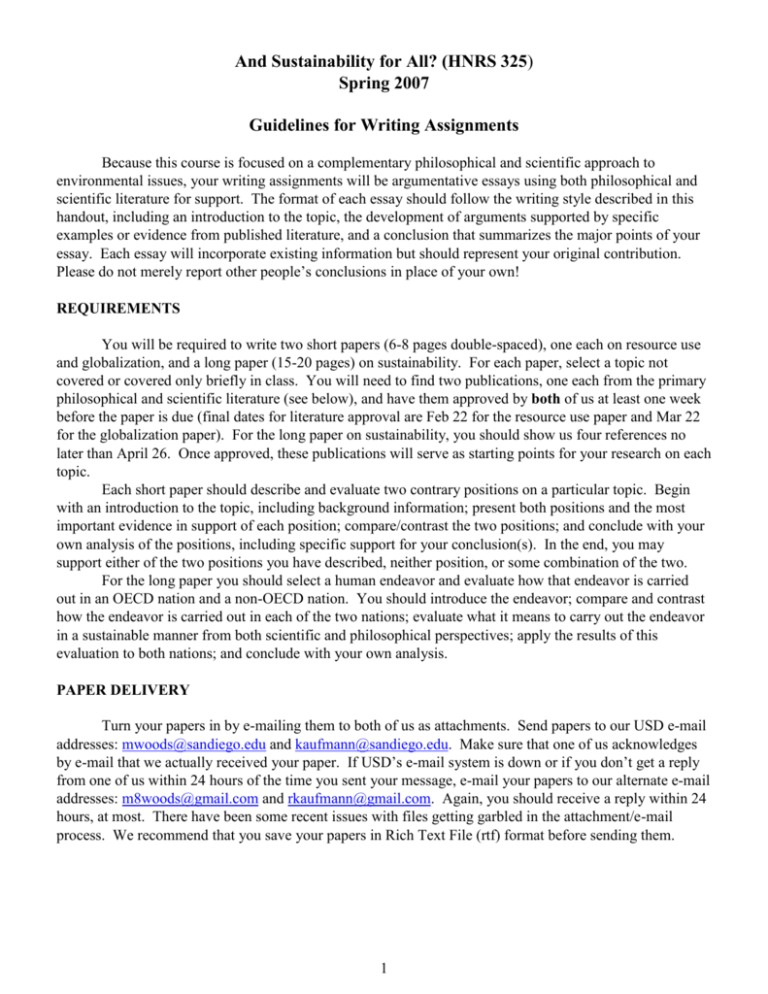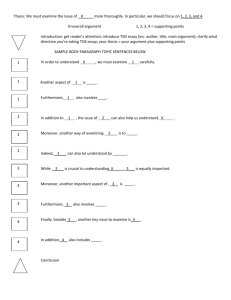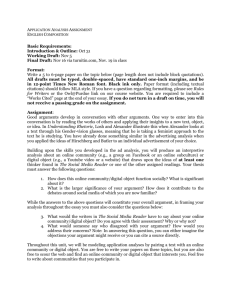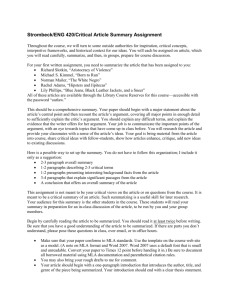Writing Guidelines - University of San Diego
advertisement

And Sustainability for All? (HNRS 325) Spring 2007 Guidelines for Writing Assignments Because this course is focused on a complementary philosophical and scientific approach to environmental issues, your writing assignments will be argumentative essays using both philosophical and scientific literature for support. The format of each essay should follow the writing style described in this handout, including an introduction to the topic, the development of arguments supported by specific examples or evidence from published literature, and a conclusion that summarizes the major points of your essay. Each essay will incorporate existing information but should represent your original contribution. Please do not merely report other people’s conclusions in place of your own! REQUIREMENTS You will be required to write two short papers (6-8 pages double-spaced), one each on resource use and globalization, and a long paper (15-20 pages) on sustainability. For each paper, select a topic not covered or covered only briefly in class. You will need to find two publications, one each from the primary philosophical and scientific literature (see below), and have them approved by both of us at least one week before the paper is due (final dates for literature approval are Feb 22 for the resource use paper and Mar 22 for the globalization paper). For the long paper on sustainability, you should show us four references no later than April 26. Once approved, these publications will serve as starting points for your research on each topic. Each short paper should describe and evaluate two contrary positions on a particular topic. Begin with an introduction to the topic, including background information; present both positions and the most important evidence in support of each position; compare/contrast the two positions; and conclude with your own analysis of the positions, including specific support for your conclusion(s). In the end, you may support either of the two positions you have described, neither position, or some combination of the two. For the long paper you should select a human endeavor and evaluate how that endeavor is carried out in an OECD nation and a non-OECD nation. You should introduce the endeavor; compare and contrast how the endeavor is carried out in each of the two nations; evaluate what it means to carry out the endeavor in a sustainable manner from both scientific and philosophical perspectives; apply the results of this evaluation to both nations; and conclude with your own analysis. PAPER DELIVERY Turn your papers in by e-mailing them to both of us as attachments. Send papers to our USD e-mail addresses: mwoods@sandiego.edu and kaufmann@sandiego.edu. Make sure that one of us acknowledges by e-mail that we actually received your paper. If USD’s e-mail system is down or if you don’t get a reply from one of us within 24 hours of the time you sent your message, e-mail your papers to our alternate e-mail addresses: m8woods@gmail.com and rkaufmann@gmail.com. Again, you should receive a reply within 24 hours, at most. There have been some recent issues with files getting garbled in the attachment/e-mail process. We recommend that you save your papers in Rich Text File (rtf) format before sending them. 1 RESEARCH A tremendous amount of information is available over the Internet, but use internet sources for your papers only with great caution. Not all of them contain verifiable, well-documented information, and relatively few are peer-reviewed, whereas most of major scientific and philosophical journals are reviewed thoroughly. Most of the literature you cite should be primary publications: books and papers written by, not about, people (philosophy) or research papers written about a specific set of experiments or observations (science), rather than a textbook-style compilation of material from multiple published sources. A good review paper can be extremely useful, but please don’t cite textbooks heavily. At a minimum, you will be expected to use (and cite!) five references (at least two philosophical and two scientific) for each short paper. For the long paper, the minimum will be eight references (at least three philosophical and three scientific). FORMAT 1. 2. 3. 4. 5. 6. Consistently leave one space between words. Consistently leave two spaces between sentences. Use double-spacing. Margins should be approximately an inch on all four sides. Use a 12 point font size. Use a readable font type such as “Times New Roman.” Please number all the pages. All papers must have titles. Do not underline your title; simply type it at the top of the first page. It is prudent to have your paper backed up somewhere on a flash drive and/or second hard drive. If you write on a computer, remember to always have back-ups and save your document continuously as you write; viruses, worms, computer failures, and power outages can make your life miserable. We recommend having the working copy of your paper on the hard drive of a computer and using flash drives only as backup. Flash drives have higher failure rates than hard drives, and it’s possible to lose all your work if your flash drive fails. 7. Use a consistent format for footnotes and references. Cite authors, article titles, book titles, editors, and publication dates at a minimum (proper citations also include the publisher and publisher’s city). For internet citations, include the complete web address and the date the page last was modified or accessed. If you quote directly, you also must cite the page number(s). The purpose of citing references is to avoid plagiarism and enable a reader to look up your sources. 8. Italicize or underline book titles, journal titles, and newspapers. Place article titles and book chapter titles in “quotation marks.” 9. Long quotations of more than two or three lines should be indented and set off from the main body of the paper without quotation marks. Short quotations of two or three lines or less should be enclosed in “quotation marks.” Be careful not to quote too much. Direct quotes should only be used (a) to invoke the crucial authority of someone else, (b) because the exact language someone else uses is crucial for your own response, or (c) because someone else says something much better than you can. If one of these circumstances holds, use a direct quote. In all other cases learn to paraphrase what other authors say. At least part of your grade for most papers is dependent on demonstrating your own understanding of other authors; excessive use of direct quotes simply shows your reader that you can reprint what other people say and not that you actually understand the meaning of what they say. 10. Do not plagiarize material from other sources. Refer to the syllabus and your instructors for questions about plagiarism and potential academic misconduct. 11. Papers are due on the day that they are due. If you anticipate having to turn in a paper late, talk to us as early as possible. If you do not talk to us ahead of time, the tardiness of your paper will lower its grade (see syllabus). 2 ARGUMENTS 1. In your paper, do not merely present your own speculations on wide, general, and not clearly defined topics. Pick one small, specific problem or issue to study in some detail. Do not make sweeping general claims without argument, proof, or evidence. Do not merely repeat other people’s beliefs. You need to clearly discuss whatever needs explication from other people, but the focus of your paper should be some single point of view of your own that you prove with logic and evidence. 2. Your paper must have a thesis toward which everything else in the paper is directed. Do not confuse a thesis with a topic. A thesis is the conclusion of your argumentative essay, and a topic is what your paper generally is about. 3. Use arguments with one or more supporting premises to prove your thesis. What you say should be logically tied together as the premise(s) and conclusion of one extended argument. You might have subarguments as part of a longer argument. Write your paper using ordinary English sentences and paragraphs, such that your paper has a clearly stated thesis that is the conclusion of an argument supported by good reasons as one or more premises. 4. Be careful not to use fallacious reasoning in your own arguments. There are many logic guides that can show you types and examples of fallacious reasoning or fallacies. 5. If you disagree with the conclusion of another person’s argument, you must either show that the conclusion does not follow the premises or you must find some specific error of falsity in one or more of the argument’s premises. 6. If you agree with the conclusion of another person’s argument and wish to defend it in your paper, then you must say something the other person did not say by extending the reach of her or his original argument or by defending the other person’s argument against possible objections. Merely agreeing with an author and/or repeating in a slightly different way what an author says does not constitute an argument of your own. LANGUAGE 1. Do not use gender-specific pronouns to refer to someone whose gender is unknown. 2. Do not use the same word to refer to different things. Many words are ambiguous and have two or more meanings. When you use such words in your paper, clearly define the meaning you wish to use for the word, and then stick to that same meaning throughout the paper. For example, don’t start out talking about “nature” as the sum total of everything there is and then shift the meaning of “nature” to be the nonhuman world. 3. Vague words that have many different meanings should be avoided or qualified. For example, do not write “society” when you mean “many people in a specific place”. “Reality” and “human nature” are other examples of vague words. 4. Be careful when using universal quantifier words such as “all”, “every”, “none”, etc. If you make a universal claim such as “All people are selfish”, and if we can find one non-selfish person on our planet of over six and a half billion people, what you have written is false. 5. There are a number of homonyms that are not interchangeable, such as “then” and “than,” “affect” and “effect,” and “a part” and “apart.” Use these kinds of words correctly. 6. In philosophy, a dilemma is a forced choice between one of two undesirable outcomes or alternatives, or having the ability to follow through with only one course of action when two courses of action are clearly indicated. A problem is a difficult matter that requires a solution. Do not confuse these terms. In most cases, when students use the term “dilemma”, they really mean “problem”. 7. In philosophy, something is a contradiction only if it has opposite truth values. Something is a contrary if it is opposed, contrasted, or in tension with something else. Do not confuse these terms. In most cases, when students use the term “contradiction”, they really mean “contrary”. 3 8. Avoid colloquialisms, slang, and slogans. Use metaphors only when absolutely necessary. Try to use words in their plain, literal sense. 9. Avoid locutions like “everybody knows that”, “obviously”, “surely”, “clearly”, etc. as a way of trying to soften your reader’s mind. Writers typically use these locutions just when they are about to sneak something by for which they have no argument. 10. If you wish to abbreviate terms and/or use acronyms for titles and phrases, fully spell out the term, title, or phrase the first time you mention it with the abbreviation/acronym immediately following it in parentheses. Here is an example: Many non-governmental groups (NGOs) in the United States (U.S.) failed to recognize not-in-my-backyard (NIMBY) phenomena in the U.S., so why should we be surprised when NGOs from the U.S. at the Earth Summit failed to recognize NIMBY phenomena in Mexico? Be careful not to use too many abbreviations or acronyms because they can turn into incomprehensible jargon. STRATEGY 1. As part of your own argument, you may have to do some conceptual analysis of key terms. For example, before you can talk about whether something harms a tree, you will first have to discuss how the concept of “harm” meaningfully can be applied to trees. 2. Everything you say should be painfully clear. We cannot read your mind, only your paper, and it is on your paper that you will be graded. Do not assume that something is already known. 3. Paragraphs should be organized around one key idea or one premise of an argument. If you have more than one key idea or premise in a paragraph, break it up into two or more paragraphs. Consistent use of very long paragraphs can strain your reader’s attention, and consistent use of very short paragraphs can make it hard for your reader to pay attention. 4. In most cases, there should be some continuity between paragraphs, unless you are starting a new section of your paper. That is, the last sentence a paragraph and the first sentence of the paragraph that follows should be somehow related or flow together. Be careful not to simply move the first sentence of a new paragraph to the end of the previous paragraph to accomplish this. 5. Begin your paper with a short introductory paragraph of several sentences that introduces your topic and thesis, perks a reader’s interest, and is commensurate with the total length of your paper. Your introduction should both introduce your paper and invite a reader into your paper. If you have problems writing an introduction, write it last after you have written the rest of your paper. 6. End your paper with a short concluding paragraph that summarizes what you have said and closes out the discussion. Do not raise new issues in the conclusion. 7. Proofread your paper before you turn it in. In the age of word processors, spell checkers, grammar checkers, and multitudes of reference material, there is no excuse for a paper that is mechanically or grammatically defective. Several suggestions for the final proofreading of your paper are to slowly read it aloud to yourself or to have a friend or family member read it. If you proofread your own paper, try to allow some time between finishing the draft and the final proofreading. * * * Seek help from us if you need it. The purpose of our office hours is to help and serve you as a student, and we can do more for you in your papers by meeting with you one-on-one than we can by writing this handout. We will be more than happy to talk, proofread, make suggestions, and/or refer you to helpful references. 4








